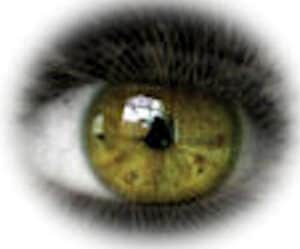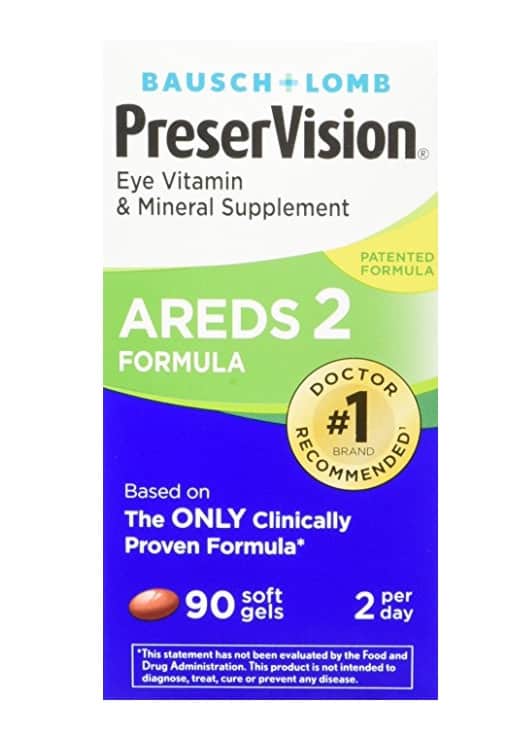The two studies differed by the amount of zinc in each formula and the substitution of lutein and zeaxanthin for beta-carotene in the AREDS2. The outcome of the 2 studies were statistically the same: 25% decrease in risk of progression of intermediate ARMD to the more severe advanced ARMD.
Those diagnosed with degenerative, hereditary, and progressive eye disease are looking for something or anything to help slow or halt the progression of their disease. Although some research has been done on supplements for eye health and some specific eye diseases, the Age-Related Eye Disease Study is the one that most of these eye vitamins are based. So a few words here on AREDS:
What is the Age Related Eye Disease Study (AREDS)?
AREDS is a study supported by the National Institute of Health (NIH) and the National Eye Institute (NEI), in collaboration with Bausch and Lomb, to look at the effectiveness of antioxidant vitamins and mineral supplements and their impact on the most common causes of vision loss among the aging population: age-related macular degeneration (ARMD) and cataracts.
There were 2 phases to the study, AREDS and AREDS2. They differ by the dosage of zinc. AREDS included beta-carotene and AREDS2 substituted lutein and zeaxanthin for the beta-carotene. (Under ‘Side Effects’ I’ll explain why beta carotene was replaced by other carotenoids.)
What is the difference between AREDS and AREDS 2?
Here is a comparison of the two formulas:
| Original AREDS | AREDS 2 | |
| Vitamin C | 500 mg | 500 mg |
| Vitamin E | 400 IU | 400 IU |
| Beta Carotene | 15 mg | 0 |
| Zinc (zinc oxide) | 80 mg | 25 mg |
| Copper | 2 mg | 2 mg |
| Lutein | 0 | 10 mg |
| Zeaxanthin | 0 | 2 mg |
| * Omega 3 Fatty Acids *included in the study, but is not a part of the official “AREDS2′ formula. | 0 | 350 mg DHA 650 mg EPA |
These dosages are above the normal dosages of typical multi-vitamins and more than can be consumed by a normally nutritious diet.
Conclusion of the AREDS 2 Study
What they concluded was that this formula is for those with intermediate ARMD (meaning some signs of ARMD with or without vision loss) and advanced ARMD (significant vision loss in one eye.) The risk of progression to advanced ARMD was reduced by 25%. Both studies, 1 and 2 achieved the same results. This means: this formula of supplement when given to those with intermediate or advanced ARMD, 1 of 4 individuals experienced a benefit. What is also significant is that 10 years later the benefits remain effective for the study participants.
It was not determined to be effective in preventing ARMD, only in decreasing the progression of existing ARMD. Other macular dystrophies like Stargardt’s and Best’s diseases were not studied.
What About Cataracts and the AREDS formula?
The formation of cataracts was determined not to be affected by the AREDS 2 supplements in those with normal dietary (from food sources) levels of lutein and zeaxanthin. But there was a small group of study participants who had low dietary intake of lutein and zeaxanthin. This group, when given the AREDS 2 supplements, did experience a decrease of 30% in development of significant cataracts progressing to cataract surgery.
What are the side effects of the AREDS?
Researchers found an increased risk for developing lung cancer in study participants who were current or former smokers taking beta-carotene. This was the rational for substituting the carotenoids; lutein and zeaxanthin for the beta-carotene in the AREDS 2 formula.
Be careful taking more than the 400 IU of vitamin E if you are also taking blood thinners like warfarin, because it will increase the risk for bleeding.
Researchers found that there was no statistical difference when they lowered the zinc from a dosage of 80 mg to 25 mg per day.
To learn more about the beneficial effects of Vitamins C and E see; Vitamins C and E: Anti-oxidants for the Aging Eye
Which is better, AREDS or AREDS2?
Each of these 2 studies were done over a 5 year period with over 4,000 study participants. The outcome of the 2 studies were statistically the same: 25% decrease in risk of progression of intermediate ARMD to the more severe advanced ARMD.
They did not find any benefit of using lutein and zeaxanthin rather than beta-carotene. But remember; the beta-carotene was determined to be responsible for the increased risk of developing lung cancer for current and former smokers. The researchers concluded that lutein and zeaxanthin were a more ‘appropriate’ choice.
Lutein and zeaxanthin were chosen because they are known to be concentrated in the macular pigment. They play a protective role as anti-oxidants and absorb UV radiation. They protect the retina and retinal pigment epithelium from oxidative stress.
Want to learn more about the benefits of lutein and zeaxanthin? Read : What is the Best Supplement to Preserve Eye and Brain Health?
They did not see any benefit of either the higher, 80 mg, or lower, 25 mg dose of zinc.
While the omega 3 fatty acids were included as a part of the AREDS 2, they were not found to make a statistical difference, and are not included in either formula Preservision AREDS or AREDS 2.
My personal recommendation is to choose the formula with lutein, zeaxanthin, and lower zinc level because of the afore mentioned reasons:
1. Lutein and zeaxanthin are concentrated in the macula and are known to be beneficial for macular protection and health, and
2. there is no known benefit to taking the higher dose of zinc.
So, are all AREDS Vitamins the same?
Since the Age-Related Eye Disease Study (AREDS), there has been an increase in the number of supplements labeled as “eye vitamins.”
The AREDS studies were done by the NEI and NiH in collaboration with Bausch and Lomb, who holds the patent (since 2013) for the AREDS2 formula. Bausch and Lomb are the producers of the PreserVision brand of eye vitamins.
The patent prohibits other manufacturers from marketing and selling their products as the AREDS 2 formula. Interestingly, there are many different combinations of supplements. Some are labeled ‘AREDS 2 based,’ indicating that the formula is similar to the study formula, but are labeled more obscurely like: Eye vitamins Plus, Premium, Gold, Maxi, Lutein, etc. If you flip the box over, and get a magnifier, you can read the names of the supplements and their dosages. It is confusing at best.
Here are just a few examples. This is in no way complete or an endorsement of any particular brands:
PreserVision and AREDS 2 Based Formulas
| Product Name | Vitamin C | Vitamin E | Zinc | Copper | Lutein | Zeaxanthin |
|---|---|---|---|---|---|---|
| PreserVision AREDS2 2 / day | 250 mg | 90 mg | 40 mg | 1 mg | 5 mg | 1 mg |
| Macular Shield | 500 mg | 400 IU | 25 mg | 1 mg | 10 mg | 2 mg |
| VisiVite AREDS2 Select | 500 mg | 268 mg | 40 mg | 1 mg | 10 mg | 2 mg |
| Focus Select 2 / day | 250 mg | 200 IU | 12.5 mg | 0 .7 mg | 5 mg | 1 mg |
| ICaps 2 / day | 250 mg | 200 IU | 12.5 mg | 1 mg | 5 mg | 1 mg |
| Nature Made Vision | 250 mg | 90 mg | 40 mg | 1 mg | 5 mg | 1 mg |
Reviewing the data you will notice they are all pretty much the same. While none of these products have additional nutrients, there are many that have added omega 3 fatty acids, astaxanthin, anthocyanins (like bilberry), and selenium. I have reviewed these other nutrients in other posts:
Eye Vitamins: The Minerals, Zinc and Selenium
Astaxanthin and Vision Benefits
Meso-zeaxanthin: The Third Carotenoid for Macular Health
Eye Vitamins: Anthocyanins of Bilberry, Blueberry, Maqui berry, and Black Currant
Eye Vitamins: Turmeric and Curcumin
Do Omega-3 Supplements Help Your Eyes?
Determining which Eye Vitamin to take:
When deciding on which eye vitamin to purchase, remember a few things:
- The AREDS was a study for determining the risk for further progression of AMD. In other words, it was not evaluated as ‘protective’ or ‘preventing,’ macular degeneration.
- Dietary supplements need not be approved for distribution, marketing, efficacy, or safety by the Food and Drug Administration (FDA). So when distributors use terms like ‘preventing’, ‘protecting,’ or supporting ocular health, there may be little evidence to support their claims.
- Watch the dosages listed by the manufacturer of the supplement. The dosage per capsule may be lower than the AREDS formula, therefore multiple dosages maybe required to achieve the same success as the AREDS results.
- Finally, always confer with your doctor before launching into large dose supplements. There are a few side effects (like beta-carotene and smokers), and some interactions with medications.
In the End…
Those with macular degeneration do not have any treatments to ‘cure’ AMD. Supplementing with anti-oxidants may delay the progression of macular degeneration to the more severe, vision threatening advanced form. While a healthy, nutritious diet provides anti-oxidants and micro-nutrients beneficial to eye health, supplementing can provide a higher and consistent level. Keep in mind, there is still a lot that is unknown about long term benefits and side effects of high dose supplements.


